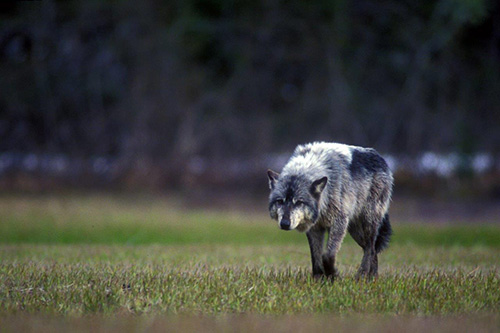
Wolf Population on Prince of Wales Island Crashes
June 08, 2015
An Alaska Department of Fish and Game draft report estimates a total of only 89 wolves in the area - including 60 on the main island - compared with 220 only a year ago. That estimate was cited in a May 29th briefing paper by the U.S. Forest Service - whose approval of the Big Thorne timber sale on the island is being challenged in court by Greenpeace and the Center for Biological Diversity and other groups. The Forest Service warns the new data “increases the probability of [an Endangered Species Act] listing and will almost certainly become a factor in ongoing litigation against timber sales.”
The "Alexander Archipelago" Wolf
The revelations come as the U.S. Fish and Wildlife Service works toward a year-end determination on whether to list the Alexander Archipelago wolf as a threatened or endangered species under the Endangered Species Act, in response to a petition filed by Greenpeace and the Center for Biological Diversity. Threats to the Alexander Archipelago wolf all stem from old-growth forest habitat loss to logging and human access to formerly remote places on the extensive system of logging roads. Right now, primary wolf habitat on Prince of Wales lays in the path of the Big Thorne timber project, a major old-growth logging effort that is being challenged in the Ninth Circuit court of appeals. “The new information is shocking and tragic,” said Sitka-based Larry Edwards of Greenpeace, who has worked on wolf issues in the region for over a decade. “A one-year 60 percent drop in population is bad enough, but the critical problem is that the Prince of Wales area population had already been reduced to a very low number. Now, the number is in the red zone.” Worse yet, the 89-wolf estimate is already outdated, the Forest Service briefing paper indicates. The “estimates were made prior to the 2014/2015 hunting and trapping season, wherein 29 animals were known to be taken. This further reduces the likely population.” These two conservation organizations say the wolves on Prince of Wales and its associated islands are geographically isolated and genetically distinct from other Alexander Archipelago wolves, which themselves are a subspecies of gray wolves. Recent genetic research shows that a large portion of genetic diversity in the gray wolf species is found in Alexander Archipelago wolves, making them especially important from a conservation perspective. According to the U.S. Froest Service Briefing Paper dated May 29, 2015, the wolf population on Prince of Wales Island alone is estimated to be 60 animals. Hunting and Trapping regulations in Alaska are established by the independent Board of Game and the board will not meet again to reconsider wolf hunting and trapping regulations prior to March 2016. The information on the new population estimate comes from a Forest Service briefing paper that summarizes the content of the Alaska Department of Fish and Game’s report. The briefing paper was provided to Greenpeace on June 4th. The final report will likely be issued this week. “After we see the full report, we will decide what actions to take,” Edwards said. “I testified to the Board of Game in January, after hearing the Department of Fish and Game’s presentation on these wolves. I said the board should close the season until the next board cycle, three years from now. That was not done, even though a crisis seemed obvious already. We are prepared to ask the Department’s commissioner for an emergency order blocking the 2015/2016 season.” The Center for Biological Diversity and Greenpeace filed the petition to protect Alexander Archipelago wolves under the Endangered Species Act in 2011. The U.S. Fish and Wildlife Service made a preliminary determination last year that listing the species “may be warranted.” The Center for Biological Diversity has been working to save the island wolf they have identified as the " the Alexander Archipelago wolf " since 1996, when the first petition was filed to protect the wolf under the Endangered Species Act. Since then, officials have continued to deny the wolf Endangered Species Act safeguards, relying instead on the general protections bestowed under broader national forest regulations. In 2011, with allies, the Center for Biological Diversity petitioned again to protect the wolf, the next year suing again after protections were delayed. It is expected that the Plaintiffs in litigation against the Big Thorne timber sale will use these numbers to argue for judgement against the Forest Service based on potential additional harm to the wolf. According to the May 29th U.S. Forest Service briefing paper, effects to wolves are one of the primary issues in litigation against the BigThorne project on Prince of Wales. The Big Thorne EIS discloses that short-term adverse impacts on local wolf populations will result from project implementation. The Alexander Archipelago wolves are not considered a unique species. According to information on the Alaska Department of Fish & Game's website, the Alexander Archipelago wolf found in Southeast Alaska is a subspecies of the gray or timber wolf. Based on common cranial characteristics, the Alexander Archipelago wolf was at one time considered by early taxonomists to be a distinct subspecies. However, recent taxonomic work suggests that these wolves may have originated from a larger subspecific group (C. l. nubilus) that at one time inhabited most of the contiguous Western United States.
Edited by Mary Kauffman, SitNews
On the Web:
Source of News:
Stories In The News Ketchikan, Alaska
|
||
